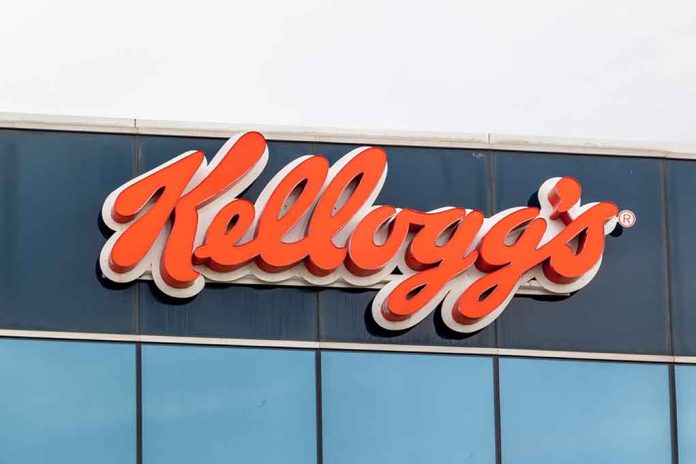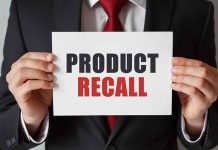
Protesters gather at Kellogg’s headquarters, demanding removal of artificial dyes from U.S. cereals amid health concerns and unfulfilled promises.
At a Glance
- Protesters rallied outside WK Kellogg Co.’s Michigan headquarters, urging removal of artificial dyes from U.S. cereals
- Kellogg promised to eliminate synthetic colors by 2018 but hasn’t fully implemented changes in the U.S.
- Over 400,000 petition signatures were delivered, citing health and behavioral concerns in children
- Kellogg claims products are safe and comply with federal regulations
- California’s new law banning certain food dyes may influence Kellogg’s future decisions
Protesters Demand Action from Kellogg
In a significant display of consumer concern, dozens to over 1,000 people assembled outside the WK Kellogg Co. headquarters in Michigan. The protesters’ mission was clear: demand the removal of artificial dyes and preservatives from popular U.S. breakfast cereals such as Froot Loops and Apple Jacks. This rally comes nearly a decade after Kellogg’s unfulfilled promise to eliminate synthetic colors and ingredients by 2018, a change that has occurred in international markets but not in the United States.
The protest highlighted a growing divide between Kellogg’s practices in the U.S. and other countries. In Canada, for instance, Kellogg uses natural colorings derived from concentrated carrot, watermelon, and blueberry juices. Meanwhile, American consumers continue to see artificial colors and the preservative BHT in their breakfast bowls.
Dozens of people rallied outside the Michigan headquarters of WK Kellogg Co. Tuesday, demanding that the company remove artificial dyes from its breakfast cereals in the U.S.
— CBS Detroit (@CBSDetroit) October 16, 2024
Health Concerns and Consumer Pressure
Activists at the rally delivered petitions boasting over 400,000 signatures, urging Kellogg to remove artificial dyes and BHT from their products. The primary concern driving this movement is the potential link between these additives and behavioral issues in children. While the U.S. Food and Drug Administration maintains that most children do not experience adverse effects from color additives, the sheer volume of signatures suggests a significant shift in consumer preferences towards more natural ingredients.
“I’m here for all the mothers who struggle to feed their kids healthy food without added chemicals,” said Vani Hari, a food activist who previously pressured Kraft Heinz to remove artificial dyes from its macaroni and cheese.
The protest included a diverse group of concerned citizens, including politicians, doctors, and nutritionists. Their unified message underscores a growing awareness of the potential risks associated with artificial food additives.
Kellogg’s Response and Market Realities
In response to the protest, Kellogg defended its safety record and compliance with federal regulations. The company emphasized its progress in removing artificial colors from many of its products, stating that over 85% of its cereal sales now contain no artificial colors. However, this statistic also highlights that a significant portion of their popular cereals still contain these controversial additives.
“Today, more than 85% of our cereal sales contain no colors from artificial sources,” the company said in a statement. “We continuously innovate new cereals that do not contain colors from artificial sources across our biggest brands, offering a broad choice of nourishing foods for our consumers.”
Kellogg’s reluctance to fully transition to natural ingredients in the U.S. market may be influenced by varying consumer preferences across different regions. The company has noted better reception to natural ingredients in Canada compared to the United States. However, recent legislative changes may force Kellogg’s hand in reconsidering its U.S. formulations.
Potential Impact of New Regulations
California’s recent passage of a law banning certain food dyes in public schools could have far-reaching implications for Kellogg and other food manufacturers. This legislation specifically affects dyes used in popular cereals like Froot Loops, potentially influencing Kellogg’s future decisions regarding product formulations nationwide.
The controversy surrounding artificial food additives extends beyond U.S. borders. Additives such as Red 40, Yellow 5, Yellow 6, Blue 1, and BHT are already banned or restricted in countries like the UK, Japan, and Canada due to health concerns. Furthermore, the European Union requires warning labels on products containing these dyes, citing potential adverse effects on children’s activity and attention.
As consumer awareness grows and regulatory pressures mount, Kellogg faces a critical juncture. The company must weigh the costs of reformulating its products against the potential loss of consumer trust and market share. The outcome of this debate could reshape the breakfast tables of millions of Americans and set a precedent for the food industry as a whole.













